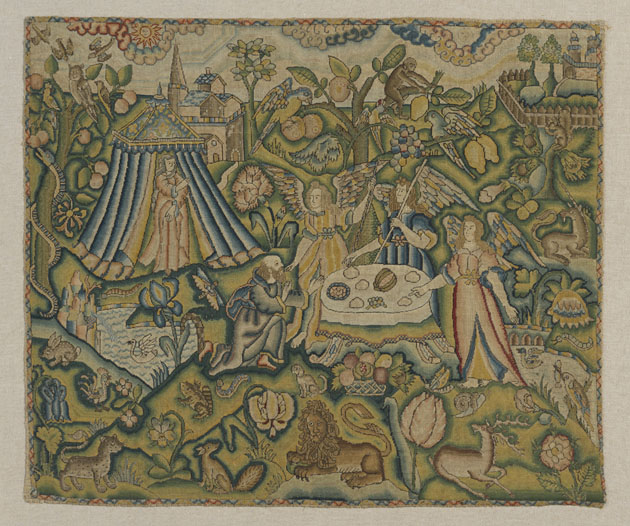Details
- Object type
embroidered panel; needlework panel
- Title
Abraham and the Three Angels
- Place Associated
England (place of manufacture)
- Date
circa 1630-1680
- Materials
linen, silk
- Dimensions
overall: 410 mm x 490 mm
- Description
-
Embroidered panel or needlework panel in linen embroidered in light blue, blue, dark blue, light brown, brown, dark brown, cream, light green, green, light grey, grey, dark grey, pink, red and yellow silk threads worked predominately in tent stitch with some cross stitch depicting Abraham offering hospitality to three angels on the plains of Mamre with Sarah in a tent set in a landscape with animals, including parrots, monkey, owl, cockerel, cockatoo, swan, dog, leopard, frog, kingfisher, unicorn, squirrel, rabbit, fox, snake, cockerel, insects, caterpillars, moth, butterfly, snail and fruit, including grapes, hazelnuts, lemons and a pomegranate.
Sarah wearing a light brown gown stands in a blue cloth tent on the left behind a pond with Abraham in a grey gown with blue stole (?) kneeling before the first Angel in a yellow and pink gown holding a staff who is standing behind a round table laden with food, with the second Angel in a blue gown also with a staff also behind the table and the third angel in a red gown with open lower skirt revealing a blue lining and yellow petticoat standing to the right, with the Angels’ eyes worked in cross stitch. In front of the table is a basket with fruit, including a pomegranate. Set in a landscape with light blue sky with clouds, a sun and the moon with a church in the upper left corner a castle in the upper right corner with two visible towers, battlements and a surrounding stockade in the back ground. Mid-ground with owl sitting on a tree with three birds flying above with a snake wrapped around the trunk on the left a fruit tree with apples, lemons and grapes with two parrots, a cockatoo and a monkey behind the angels and a small tree with a squirrel on the right. A pond on the left with coral and swan, with a rabbit, cockerel, frog, caterpillar and iris and a second pond on the right with a duck and kingfisher. Foreground with leopard, pansy, fox, flower, small dog, lion couchant, tulip, butterfly, snail, stag and rose.
Today the terms embroidery and needlework can be used synonymously, however, during the late 1500s to early 1700s the terms were applied to two different techniques. Embroidery referred to items worked with a variety of predominately surface stitches, such as detached buttonhole and satin, that did not completely cover the ground fabric, which was often a silk satin. Needlework was the term used for linen items that were completely covered with stitches worked mainly in tent or cross stitch.
The story of Abraham offering hospitality to three Angels on the Plains of Mamre is from Genesis (18:1–16). The three Angels, symbolising the Holy Trinity, tell Abraham of imminent birth of his son, Isaac, to his elderly wife Sarah, who was believed to be infertile, in a scene prefiguring the Annunciation. The Biblical story was often depicted in a series of engravings, such as those after Maarten de Vos (1532–1603) published in Gerard de Jode (1509–91), Thesaurus Sacrarum Historiam Veteris Testamenti, Antwerp, 1585. The first scene shows Abraham kneeling before three angels who tell him that Sarah will have a son. A needlework panel that is relatively close to this print source is in the Ashmolean Museum, Oxford (WA1947.191.314). Whilst the positioning of all the figures on the needlework panel in the Burrell Collection is similar, their exact postures differ from the illustration in Gerard de Jode, which may indicate a different print source was used for this panel.
Provenance: Frank Partridge & Sons, London; from whom purchased by William Burrell on 8 April 1919 for £140.
- Credit Line/Donor
Gifted by Sir William and Lady Burrell to the City of Glasgow, 1944
- Collection
Burrell Collection: British Embroideries
- ID Number
29.43
- Location
In storage
- Related People
Frank Partridge & Sons dealer
